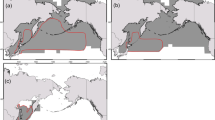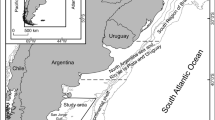Abstract
The Red Deer River, Alberta, Canada is a prairie river that is impacted by the point-source input of Red Deer’s municipal wastewater effluent and non-point- source agricultural runoff. We used population, growth, and physiological performance end points in longnose dace (Rhinichthys cataractae), an endemic and abundant minnow, to evaluate changes in fish health over a 220 km section of the Red Deer River. Longnose dace immediately downstream of Red Deer had elevated catch per unit effort with larger body and liver sizes compared to upstream of Red Deer sites, likely due to elevated riverine productivity from Red Deer’s wastewater effluent. Longnose dace immediately downstream of Red Deer showed depressed testosterone production capacity and elevated ethoxyresorufin-O-deethylase (EROD) activity, which is consistent with exposure to endocrine-disrupting compounds and aromatic hydrocarbons, respectively. Longnose dace 150–180 km downstream of Red Deer had reduced liver and gonad sizes, elevated EROD, and increased 11-ketotestosterone production capacity compared to upstream of Red Deer sites, possibly related to a non-point-source agricultural influence on water quality. Longnose dace populations at the most downstream sites were missing the oldest age classes and might reach sexual maturity faster than at upstream sites, which is consistent with a younger age structure. Our results highlight the importance of assessing multiple performance end points to reveal physiological or reproductive effects in natural fish populations. We have demonstrated how longnose dace populations change over a river impacted by municipal wastewater and agricultural runoff; further studies are required to determine if these changes will influence the long-term viability of longnose dace in the Red Deer River.






Similar content being viewed by others
References
Adams SM, Ham KD, Greeley MS, LeHew RF, Hinton DE, Saylor CF (1996) Downstream gradients in bioindicator responses: point source contaminant effects on fish health. Can J Fish Aquat Sci 53:2177–2187
Alberta Environment (2004) River network station water quality data. Available from www3.gov.ab.ca/env/water/reports/water_quality_reports.cfm. Accessed December 15, 2005
Anderson A (2005) Overview of pesticide data in Alberta surface waters since 1995. Technical Report T/772. Environmental Monitoring and Evaluation Branch, Alberta Environment, Edmonton, Alberta
Baumann PC, Harshbarger JC, Hartman KJ (1990) Relationship between liver tumors and age in brown bullhead populations from two Lake Erie tributaries. Sci Total Environ 94:71–87
Chambers PA, Dale AR, Scrimgeour GJ, Bothwell ML (2000) Nutrient enrichment of northern rivers in response to pulp mill and municipal discharges. J Aquat Ecosyst Stress Recov 8:53–66
Culp JM, Podemski CL, Cash KJ (2000) Interactive effects of nutrients and contaminants from pulp mill effluents on riverine benthos. J Aquat Ecosyst Stress Recov 8:67–75
Dubé MG, MacLatchy DL, Firth BK, Culp JM, Glozier NE, Cash KJ (2004) Using mesocosms to explore confounding factors influencing longnose dace (Rhinichthys cataractae) responses to kraft mill effluent on the Wapiti River, AB, Canada. In: Borton DL, Hall TJ, Fisher RP, Thomas JF (eds) Pulp and paper mill effluent environmental fate and effects, Proceedings of the fifth international conference on the fate and effects of pulp and paper mill effluent. DEStech Publication, Lancaster, PA, pp 481–490
Efler S, Hodson PV, Wilson JY (1997) Bioassay for measuring the potency of effluents for inducing the activity of ethoxyresorufin-O-deethylase (EROD) in fish liver. Canada Centre for Inland Waters, National Water Research Institute, Burlington, Ontario
Evanson M, Van Der Kraak GJ (2001) Stimulatory effects of selected PAHs on testosterone production in goldfish and rainbow trout and possible mechanisms of action. Comp Biochem Physiol 130C:249–258
Feist GW, Webb MAH, Gundersen DT et al (2005) Evidence of detrimental effects of environmental contaminants on growth and reproductive physiology of white sturgeon in impounded areas of the Columbia River. Environ Health Perspect 113:1675–1682
Folmar LC, Denslow ND, Kroll K et al (2001) Altered serum sex steroids and vitellogenin induction in walleye (Stizostedion vitreum) collected near a metropolitan sewage treatment plant. Arch Environ Contam Toxicol 40:392–398
Foster EP, Fitzpatrick MS, Feist GW et al (2001) Plasma androgen correlation, EROD induction, reduced condition factor and the occurance of organochlorine pollutants in reproductively immature white sturgeon (Acipenser transmontanus) from the Columbia River, USA. Arch Environ Contam Toxicol 41:182–191
Fraker ME, Snodgrass JW, Morgan F (2002) Differences in growth and maturation of blacknose dace (Rhinichthys atratulus) across an urban–rural gradient. Copeia 4:1122–1127
Gibbons WN, Munkittrick KR, Taylor WD (1998) Monitoring aquatic environments receiving industrial effluents using small fish species 1: response of spoonhead sculpin (Cottus ricei) downstream of a bleached-kraft pulp mill. Environ Toxicol Chem 17:2227–2237
Gray MA, Curry AR, Munkittrick KR (2002) Non-lethal sampling methods for assessing environmental impacts using a small-bodied sentinel fish species. Water Qual Res J Can 37:195–211
Hill J, Grossman GD (1987) Home range estimates for three north American stream fishes. Copeia 2:376–380
Hogberg LK (2004) A chemical, biological, and isotopic analysis of the spatial extent of wastewater effluent on rivers in Southern Alberta, Canada. MSc Thesis, University of Calgary, Calgary, Alberta
Janz DA, McMaster ME, Weber LP, Munkittrick KR, Van Der Kraak G (2001) Recovery of ovary size, follicle cell apoptosis, and HSP70 expression in fish exposed to bleached pulp mill effluent. Can J Fish Aquat Sci 58:620–625
Kolpin DW, Furlong ET, Meyer MT et al (2002) Pharmaceuticals, hormones, and other organic wastewater contaminants in US streams, 1999–2000: a national reconnaissance. Environ Sci Technol 36:1202–1211
Labadie P, Budzinski H (2006) Alteration of steroid hormone balance in juvenile turbot (Psetta maxima) exposed to nonylphenol, bisphenol A, tetrabromodiphenyl ether 47, diallylphthalate, oil, and oil spiked with alkylphenols. Arch Environ Contam Toxicol 50:552–561
Lavado R, Thibaut R, Raldua D, Martin R, Porte C (2004) First evidence of endocrine disruption in feral carp from the Ebro River. Toxicol Appl Pharmacol 196:247–257
Mackay WC, Ash GR, Norris HJ (1990) Fish ageing methods for Alberta. R. L. & L. Environmental Services Ltd., Edmonton, Alberta
MacLatchy DL, Courteney SC, Rice CD, Van Der Kraak GJ (2003) Developing of a short-term reproductive endocrine bioassay using steroid hormone and vitellogenin end points in the estuarine mummichog (Fundulus heteroclitus). Environ Toxicol Chem 22:996–1008
Marcogliese DJ, Cone DK (2001) Myxozoan communities parasitizing Notropis hudsonius (cyprinidae) at selected localities on the St. Lawrence River, Quebec: possible effects of urban effluents. J Parasitol 87:951–956
Marcogliese DJ, Dumont P, Gendron AD, Mailhot Y, Bergeron E, McLaughlin JD (2001) Spatial and temporal variation in abundance of Diplostomum spp. in walleye (Stizostedion vitreum) and white suckers (Catostomus commersoni) from the St. Lawrence River. Can J Zool 79:355–369
McMaster ME, Munkittrick KR, Jardine JJ, Robinson RD, Van Der Kraak G (1995a) Protocol for measuring in vitro steroid production by fish gonadal tissue. Canadian Technical Report of Fisheries and Aquatic Sciences 1961, Department of Fisheries and Oceans, Burlington, Ontario
McMaster ME, Van Der Kraak GJ, Munkittrick KR (1995b) Exposure to bleached kraft pulp mill effluent reduces the steroid biosynthetic capacity of white sucker ovarian follicles. Comp Biochem Physiol 112:169–178
McMaster ME, Hewitt ML, Tetreault GR et al (2004) detailed endocrine assessments in wild fish within the northern river basins. Northern Rivers Ecosystems Initiative, Burlington, Ontario
Mills LJ, Chichester C (2005) Review of evidence: are endocrine-disrupting chemicals in the aquatic environment impacting fish populations? Sci Total Environ 343:1–34
Munkittrick KR, Dixon DG (1989) Use of white sucker (Catostomus commersoni) populations to assess the health of aquatic ecosystems exposed to low-level contaminant stress. Can J Fish Aquat Sci 46:1455–1462
Munkittrick KR, Van Der Kraak GJ, McMaster ME, Portt CB, Van den Heuvel MR, Servos MR (1994) Survey of receiving-water environmental impacts associated with discharges from pulp mills. 2. Gonad size, liver size, hepatic EROD activity and plasma sex steroid levels in white sucker. Environ Toxicol Chem 13:1089–1101
Munkittrick KR, McMaster ME, Van Der Kraak G et al (2000) Development of methods for effects-driven cumulative effects assessment using fish populations: Moose River Project. Society of Environmental Toxicology and Chemistry Press, Florida
Nelson JS, Paetz MJ (1992) The fishes of Alberta. University of Alberta Press, Edmonton, pp 170–174
Palace VP, Wautier KG, Evans RE et al (2006) Biochemical and histopathological effects in pearl dace (Margariscus margarita) chronically exposed to a synthetic estrogen in a whole lake experiment. Environ Toxicol Chem 25:1114–1125
Parrot JL, Jardine JJ, Blunt BR et al (1999) Comparing biological responses to mill process changes: a study of steroid concentrations in goldfish exposed to effluent and waste streams from a Canadian bleached sulphite mill. Water Sci Technol 40:115–121
Power M (2002) Assessing fish population responses to stress. In: Adams SM (ed) Biological indicators of aquatic ecosystem stress. American Fisheries Society, Bethesda, MD, pp 379–429
Roberts JH, Grossman GD (2001) Reproductive characteristics of female longnose dace in the Coweeta Creek drainage, North Carolina, USA. Ecol Freshwater Fish 10:184–190
Scott WB, Crossman EJ (1998) Freshwater fishes of Canada. Galt House Publications Ltd., Oakville, Ontario, pp 494–498
Sokal RR, Rohlf FJ (1981) Biometry: the principals and practice of statistics in biological research. W.H. Freeman, San Francisco
Sole M, Barcelo D, Porte C (2002) Seasonal variation of plasmatic and hepatic vitellogenin and EROD activity in carp, Cyprinus carpio, in relation to sewage treatment plants. Aquat Toxicol 60:233–248
Sosiak A, Hebben T (2005) A preliminary survey of pharmaceuticals and endocrine disrupting compounds in treated municipal wastewaters and receiving rivers of Alberta. Technical Report T/773. Environmental Monitoring and Evaluation Branch, Alberta Environment, Edmonton, Alberta
Steyermark AC, Spotila JR, Gillette D, Isseroff H (1999) Biomarkers indicate health problems in brown bullheads from the industrialized Schuylkill River. Trans Am Fish Soc 128:328–338
Sumpter JP (1995) Feminized responses in fish to environmental estrogens. Toxicol Lett 82/83:737–742
Tetreault GR, McMaster ME, Dixon DG, Parrott JL (2003) Using reproductive endpoints in small forage fish species to evaluate the effects of Athabasca oils sands activities. Environ Toxicol Chem 22:2775–2782
West DW, Ling N, Hicks BJ, Tremblay LA, Kim ND, Van Den Heuvel MR (2006) Cumulative impacts assessment along a large river, using brown bullhead catfish (Ameiurus nebulosus) populations. Environ Toxicol Chem 25:1868–1880
Acknowledgments
This project was financially supported by an Undergraduate Student Research Award from the Natural Sciences and Engineering Research Council (NSERC) of Canada to KMJ and a Canadian Water Network research grant to LJJ. We also thank numerous volunteers who assisted in field collections, especially Marc Gautreau and Sandy Brasfield. The manuscript was greatly improved by the careful reviews of two anonymous reviews.
Author information
Authors and Affiliations
Corresponding author
Rights and permissions
About this article
Cite this article
Jeffries, K.M., Jackson, L.J., Peters, L.E. et al. Changes in Population, Growth, and Physiological Indices of Longnose Dace (Rhinichthys cataractae) in the Red Deer River, Alberta, Canada. Arch Environ Contam Toxicol 55, 639–651 (2008). https://doi.org/10.1007/s00244-008-9146-1
Received:
Accepted:
Published:
Issue Date:
DOI: https://doi.org/10.1007/s00244-008-9146-1




